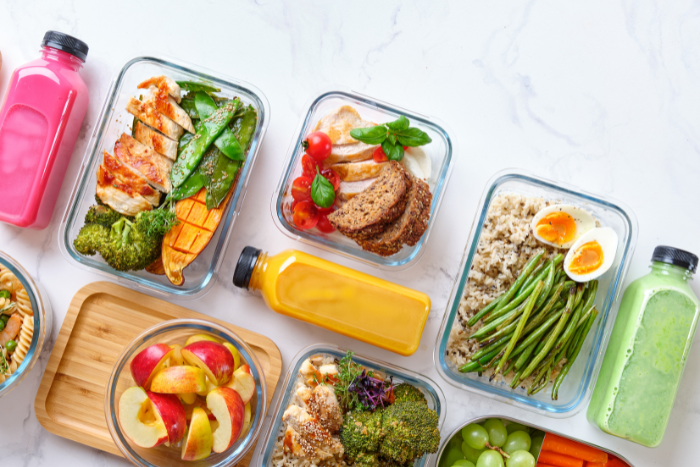Low-Inflammation Meal Planning: A Beginner’s ND Guide
Chronic inflammation is a root cause of many health issues, including joint pain, digestive discomfort, fatigue, and even heart disease. Fortunately, adopting a low-inflammation diet can help manage symptoms and support overall health. For residents in Erin Mills and Mississauga, integrating anti-inflammatory meals into daily life doesn’t have to be complicated.
At Aurika Wellness, our naturopathic doctors guide clients through practical dietary strategies that reduce inflammation naturally, improve energy, and support long-term wellness. This blog provides a beginner-friendly roadmap for getting started.
An anti-inflammatory diet focuses on whole, unprocessed foods that help reduce the body’s inflammatory response. Key principles include:
.png?width=700&height=467&name=meal%20plan%20(2).png)
Breakfast:
This type of plan balances protein, healthy fats, fibre, and micronutrients while minimizing inflammatory triggers.

Lifestyle Habits to Support Anti-Inflammatory Eating
Diet alone isn’t enough to manage inflammation effectively. Combining nutrition with healthy lifestyle habits amplifies benefits:
At Aurika Wellness, our naturopathic doctors guide clients through practical dietary strategies that reduce inflammation naturally, improve energy, and support long-term wellness. This blog provides a beginner-friendly roadmap for getting started.
What is an Anti-Inflammatory Diet?
An anti-inflammatory diet focuses on whole, unprocessed foods that help reduce the body’s inflammatory response. Key principles include:
- High intake of fruits and vegetables: Packed with antioxidants that fight oxidative stress.
- Healthy fats: Omega-3 fatty acids from salmon, chia seeds, and walnuts help modulate inflammation.
- Lean proteins: Chicken, turkey, and legumes provide essential amino acids without promoting inflammation.
- Whole grains: Brown rice, quinoa, and oats supply fibre to support gut health.
- Spices with anti-inflammatory properties: Turmeric, ginger, and garlic are well-studied for their effects.
.png?width=700&height=467&name=meal%20plan%20(2).png)
Sample Meal Plan for Beginners
Here’s a practical example of a day’s low-inflammation meals:Breakfast:
- Oatmeal with fresh berries, flaxseeds, and a sprinkle of cinnamon.
- Green tea or herbal tea for antioxidants.
Mid-Morning Snack: - Apple slices with almond butter or a handful of walnuts.
Lunch: - Quinoa salad with roasted vegetables, chickpeas, olive oil, and lemon dressing.
- Optional grilled salmon or chicken for additional protein.
Afternoon Snack: - Carrot sticks with hummus or a small serving of Greek yogurt with berries.
- Baked salmon with steamed broccoli and sweet potato.
This type of plan balances protein, healthy fats, fibre, and micronutrients while minimizing inflammatory triggers.

Lifestyle Habits to Support Anti-Inflammatory Eating
Diet alone isn’t enough to manage inflammation effectively. Combining nutrition with healthy lifestyle habits amplifies benefits:
- Regular physical activity: Walking, yoga, or strength training supports circulation and reduces inflammatory markers.
- Stress management: Meditation, deep breathing, and mindfulness help modulate cortisol levels.
- Adequate sleep: Poor sleep contributes to inflammation, so prioritize 7–9 hours per night.
- Hydration: Water and herbal teas support detoxification and nutrient transport.
Integrating these habits alongside a low-inflammation diet produces more noticeable results.
Foods to Limit or Avoid
While focusing on anti-inflammatory foods, it’s also important to minimize pro-inflammatory foods, such as: - Processed meats (hot dogs, sausages)
- Deep-fried foods and hydrogenated oils
- Excessive alcohol
Even occasional indulgences are fine, but consistent reduction can significantly improve symptoms over time.
How a Naturopath Can Help
A naturopathic doctor can personalize an anti-inflammatory plan to your unique health profile, taking into account:- Food sensitivities or allergies
- Digestive health and gut microbiome
- Blood work and inflammatory markers
- Lifestyle, activity level, and stress
At Aurika Wellness in Erin Mills, Mississauga, our NDs provide practical guidance, recipes, and tracking strategies to make anti-inflammatory eating realistic and sustainable.
FREQUENTLY ASKED QUESTIONS
How soon can I expect to see results from a low-inflammation diet?
Some improvements in energy, digestion, or pain may occur within a few weeks. Long-term effects on chronic inflammation typically appear after several months of consistent practice.
Can I still eat carbs on an anti-inflammatory diet?
Yes, focus on whole, unprocessed carbohydrates like quinoa, brown rice, oats, and vegetables. Avoid refined or sugary carbs.
Are spices like turmeric and ginger really effective?
Research supports anti-inflammatory properties of these spices, especially when combined with healthy fats for absorption.
Is an anti-inflammatory diet suitable for everyone?
Generally yes, but individual considerations such as allergies, digestive issues, or chronic conditions should be addressed with a naturopath.
%20-%20Edited.png?width=150&height=103&name=Final%20LOGO@4x%20(2)%20-%20Edited.png)



.png?width=352&name=Sport%20massage%20(1).png)